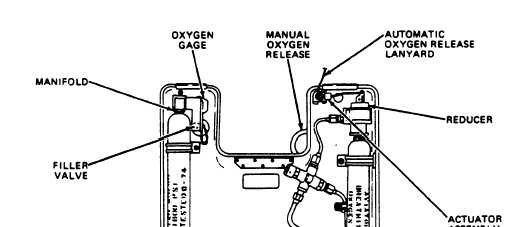Figure 7-3.—Emergency oxygen schematic.
these are high-performance aircraft that can
operate at high altitudes. Therefore, in addition
to containing survival gear, the kit also furnishes
oxygen to the aviator when he ejects at altitudes
where there is not enough oxygen to maintain
consciousness.
When the aircrewman ejects from the aircraft,
the following events occur:
The automatic actuation lanyard for the
emergency oxygen system actuates the reducer
assembly at seat ejection. The aircrewman is then
supplied emergency oxygen for descent (fig. 7-3).
If automatic actuation of the emergency oxygen
system fails, the emergency oxygen system may
be actuated by the aircrewman by means of the
manual oxygen release (green ring). The radio
beacon is automatically actuated by another
actuation lanyard. The beacon provides a con-
tinuous signal during descent.
When a safe altitude is reached, the air-
crewman pulls the kit release handle free of the
kit. This unlocks the containers and the lower half
falls away but remains attached by the dropline
assembly. The life raft, attached to the dropline,
is automatically inflated.
239.555
INSPECTIONS
Your concern with this unit is mainly in
inspecting it at scheduled intervals or when
damage might be suspected. There are three types
of inspections made at routine intervals: the
turnaround/daily/preflight/postflight/transfer,
special inspections, and the more detailed ac-
ceptance/phased/SDLM inspections. In addi-
tion, conditional inspections are unscheduled
inspections required as the result of a specific
situation or set of conditions; for example, hard-
landing inspections or any inspection directed by
higher authority that is not ordered in a technical
directive.
The turnaround/daily/preflight/postflight or
transfer inspections consist of a visual-type
inspection performed in conjunction with the
aircraft inspection requirements for the aircraft
in which the survival kit is installed. These
inspections are performed by line personnel (plane
captain) or delegated aircrewman who have been
instructed and found qualified by the aviator’s
equipment branch.
The special (7/14 day, etc.) inspections are
performed on inservice survival kits installed in
7-3



